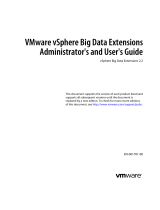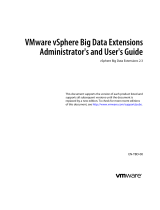Page is loading ...

Applies to version 3.5.0.20 or later
Yealink Device Management Platform Quick Start Guide

Getting Started
Hardware and Software Requirements
Overview
Yealink Device Management Platform (YDMP) allows administrators to realize centralized management for Yealink IP phones, Skype for
Business HD T4XS IP phones, video conferencing systems, MVC series and others in the same enterprise.
1
YDMP supports the stand-alone installation and the cluster installation since version 3.5.0.20. Different installation methods has different
hardware and software requirements.
For virtual machine, we support VMware ESXi in version 6.5 or later. For Linux operating system, we support CentOS7.5 and CentOS8.1
(supported since version 3.5.0.20).
Device Quantity Hard Drive
0~6000
6000~15000
16G
15000~30000
CPU
8-core
16-core
32-core
RAM
32G
64G
Requirements for stand-alone installation:
Requirements for each server in cluster installation
(3 servers are required and the requirements for each server are the same):
Device Quantity Hard Drive
0~30000
30000~50000
16G
50000~100000
CPU
8-core
8-core
16-core
RAM
24G
24G
At least 250G, and the capacity of the hard
drive increases by 30G with every 1000
devices added.
At least 250G for 6000 devices, and the
capacity of the hard drive should be increased
by 30G with every 1000 devices added.

Installing YDMP
Before you begin
• One device running CentOS.
• Your hardware, software and ports should meet the requirements.
• Obtain the latest installation package of YDMP from the Yealink distributor or SE and then save it at the path /usr/local.
Note: If you want to upgrade YDMP to the version later than 3.5.0.20 (including 3.5.0.20), you can install it directly.
Procedure
1. Log into CentOS as the root user and open the terminal.
2. Run the command below:
cd /usr/local
tar zxvf DM-release-3.5.0.20.tar.gz
cd yealink_install/
tar zxvf install.tar.gz
./install
##This is the single NIC deployment, for more information, refer to the administrator guide.##
3. For the stand-alone installation, select A. If you do not select one within 30 seconds, the system will select A automatically.
Enter the IP address according to the prompts. If the server has only one IP address, enter it. If the server has several IP addresses, enter
the internal IP address.
4. For the cluster deployment, select B and edit the configuration template usr/local/yealink/data/install.conf.
• If it is the deployment of single NIC (the internal or external network), you only need to edit the ip=x.x.x.x in the master node.
• If it is the deployment of dual NIC (the internal and the external network), you need to edit ip=x.x.x.x as the internal IP address and
wan_ip=x.x.x.x as the external IP address. You need to edit the internal and external IP address in the corresponding field.
• After editing the parameter, you need to delete the comment symbol # in front of the parameter.
• You need to employ the domain name for the following configuration:
microdm_tcp_server_address
microdm_mail_web_domain
microdm_domain
Port Requirements
You need open five ports for YDMP: 443, 8446, 9989, 9090, and 80. We do not recommend that you modify those ports.
2

3
The installation starts and takes some time to finish. For the cluster deployment, you can use the domain name to log into YDMP if your
installation successes.

1. Open a web browser.
2. Enter https://<IP address>/ (for example: https://10.2.62.12/) in the address box.
3. Optional: select a desired language.
4. Enter your username (default: admin) and the password (default: v123456789), and click Login.
5. If it is the first time you log into the platform, the system will remind you to change the password. After that, you can go to the Home
page of YDMP.
4
Step1: Importing the Device Certificate
1. Obtain the device certificate from your service provider by submitting the company name, the distributor name and the country.
2. Follow the instructions in the picture below to upload the certificate.
After activating the license, you can manage your devices via YDMP.
Logging into YDMP
Activating the License

Step2: Activating the License
5
1. You need purchase the corresponding service and obtain the authorization for the device management.
2. If the server can access the public network, you can activate the license online. Otherwise, you can activate the license offline.
※ Online
※ Offline

Importing the Lastest Parameter Configuration File
6
If your YDMP is upgraded from a lower version, you must import the lastest parameter configuration file. Otherwise, you cannot use some device
models. You can update the configuration by downloading the latest configuration file from Yealink official website. If the configuration is updated,
the parameters in the template will be updated synchronously. You can download the latest configuration file from
http://support.yealink.com/documentFront/forwardToDocumentDetailPage?documentId=243
Importing the HTTPS Certificate
For the cluster deployment, you need to import HTTPS certificate. Otherwise, it will affect the mutual authentication between the phone and the server and
cause the failure of pushing the configuration and firmware.
1. Run command: cd /usr/local/yealink/nginx/conf/ssl/.
2. Replace the content in the nginx.pem file with the one in HTTPS certificate.
3. Run command: systemctl restart nginx

7
1. Connect the device to the network.
2. The device and the server perform mutual TLS authentication using default certificates.
3. Obtain the server address:
With a running provisioning server, you need to configure the corresponding Common.cfg file (for example, <y0000000000xx>.cfg).
In the corresponding Common.cfg file, do the following:
① If the firmware does not support YMDP, you need configure the parameters.
② Configure the provisioning URL to connect the device to YDMP.
Without a running provisioning server, you can obtain the server address via the DHCP option 66, 43, 160 or 161.
The DHCP option value must meet this format: https://<IP address>/dm.cfg (for example: https://10.2.62.12/dm.cfg).
After you finish the deployment, the device will be connected to YDMP and be displayed in the Device List.
Deploying the SIP Device
Deploying the MVC Series
On your MTouch, open Yealink Room Connect, go to Remote Management, and configure the related parameters. After that, the MVC series
will be connected to YDMP automatically.

※ Configuring and Updating the Parameter to the Device
Managing the Configuration
※
Adding the Configuration Template
Step 1: click to go to the Set Template Parameters page.
8
Deploying the USB Devices
Open USB Device Manager client, go to Config DM Server, and complete the corresponding configuration. The USB Device will be connected
to the device management platform automatically.

Step3: Update the device configuration file immediately.
9
6
Step 2: Configure the parameters.

Step 4: Push the parameters to update it.
Step 5: Select the execution mode.
10

11
SMTP mailbox can be used to send the related information to the users or the administrators, such as the alarm and the account informa-
tion.
Setting the SMTP Mailbox

12
When the devices are abnormal, they will send alarms to the platform. You can solve the problem by managing the alarms.
Before you begin
You set the SMTP mailbox (on page 9).
Editing the Mailbox
※
This mailbox is used for receiving the alarm and the account information.
Managing the Alarm

13
※
Adding the Alarm Strategy
Viewing the Alarm
※

14
More Information
For more information about YDMP, refer to http://support.yealink.com/.
/

